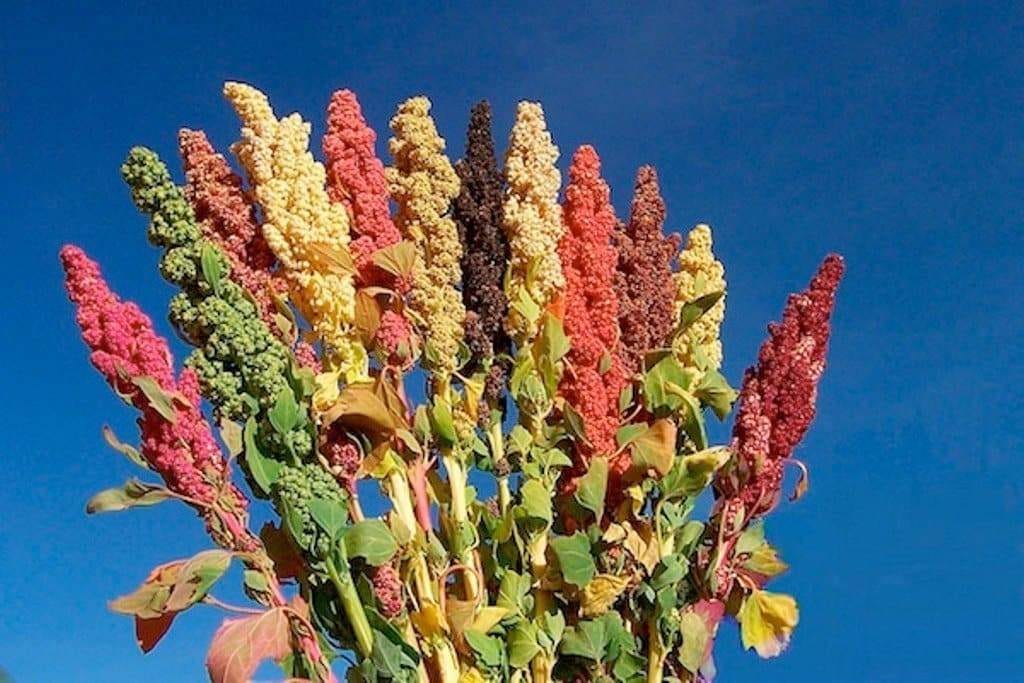Quinoa salad, and not taking the staples for granted.
Adapted from: the ancient cooking of the Andes.
It occurred to me, while rinsing the quinoa for this salad, that I had no idea what quinoa was.
It’s funny how you can eat something for years without truly understanding what you’re eating. [Narrator: She did not, in fact, find this funny.] For example, I thought quinoa was a grain. Turns out it’s not: it’s the seed of a flowering plant in the amaranth/spinach family.
If you’ve been reading this newsletter for a little while, you’ll recognize that this sudden awareness of my sheer and utter ignorance strikes often. Not surprising, for someone whose interactions with food start at the grocery store and end on her plate, obfuscating the many steps that precede this leg of the journey in the global food supply chain. I am, not for lack of curiosity, accustomed to thinking of quinoa as a raw material, not a polished commodity. Something to make a recipe with, rather than the product of someone’s making.
But of course, someone made this quinoa. Someone grew it, and someone harvested it. Someone washed it, and someone processed it, before someone else bagged it, distributed it, sold it to retailers, and placed it on the shelf for me. My bag of red quinoa was imported by GoGoQuinoa, a company from Laval, Québec (with the most vague corporate social responsibility page I have ever seen). It was packaged in Canada and grown in Bolivia. I wonder how many stops it made in-between.
Although quinoa is a relatively new addition to the diets of North Americans (remember all the commercials from a few years ago that taught you, the uneducated consumer, how to pronounce it?), it has been cultivated for millennia in the Andean region of South America. It was a staple of the Inca, who called it the mother grain, and saw it as a gift from the gods.
Today, it’s a gift that comes with its own asterisks. Even though quinoa is lauded as a miracle food, a protein-rich staple for vegetarians and vegans, this popularity comes at a cost. I mentioned it briefly in the oxtail newsletter, but the price of quinoa tripled from 2006-2013, and the South American farmers who grow it (99% of the world’s quinoa is still grown in Peru and Bolivia) were priced out. In fact, according to The Guardian:
The appetite of countries such as ours for this grain has pushed up prices to such an extent that poorer people in Peru and Bolivia, for whom it was once a nourishing staple food, can no longer afford to eat it. Imported junk food is cheaper. In Lima, quinoa now costs more than chicken. Outside the cities, and fuelled by overseas demand, the pressure is on to turn land that once produced a portfolio of diverse crops into quinoa monoculture.
The rising prices did, according to some agricultural economists, reap financial benefits for those in the region. But nevertheless, dwindling interest in less commercial varietals and the environmental degradation from over-farming remain crucial concerns.
So what is the right answer? I’m not sure there is one. Farmers in South America depend on our consumption, so it’s not like we should boycott quinoa entirely. Maybe we source directly from suppliers in the region. Maybe we support companies with more transparent fair trade policies. As always, I feel the imperative to chip away at the tip of the iceberg, to keep asking questions. Even if they’re as perfunctory as “What is quinoa, anyway?”
Recipe notes:
Rainbow Quinoa Salad With Mixed Nuts, Herbs and Dried Fruit
This is a recipe I plan to make a lot over the coming months, with a few notes:
• I did not know where to get pomegranate molasses, so replaced it with equal parts maple syrup and balsamic reduction. So good.
• I’m starting to hate the taste of cilantro (SOB), so I omitted it and replaced it with more parsley and mint.
• Half a garlic clove in the dressing was perfect. I live in fear of botulism, despite not knowing exactly how botulism develops.
Quinoa recipes from the source:
From Peru, a creamy, stewed dish called quinoa atamalada (tamal-like, but can be likened to risotto as well), via Pisco Trail.
From Bolivia, papitas - a quinoa fritter stuffed with tuna. Via 196 Flavors.
Tell me: what is a fundamental food you were surprised to learn about?
Until next time,
Tracy


